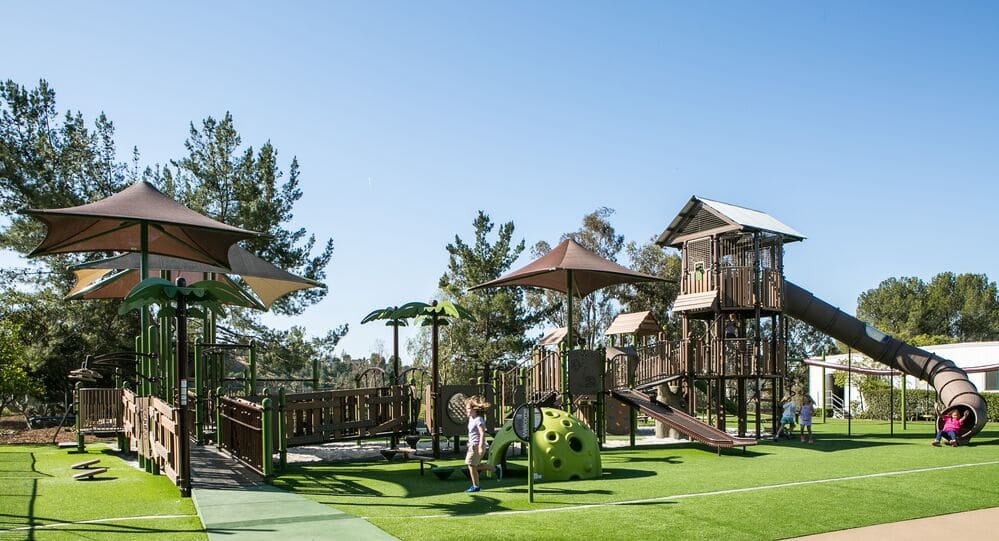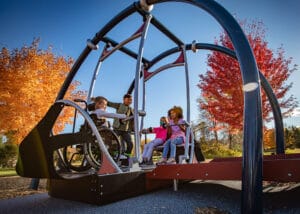How Does Architecture Incorporate Principles Of Inclusive Playground Design?

As children, we all looked forward to jumping on the swings, sliding down the slide, and running around the playground with our friends. However, for children with disabilities, the playground may not be as accessible, making it difficult for them to join in on the fun. Fortunately, there are efforts to create inclusive playgrounds, such as the Variety Inclusive Playground in progress, designed by OUTHOUSE design.
What is an Inclusive Playground?
An inclusive playground is a play area that is designed to be accessible to all children, including those with disabilities. Traditional playgrounds often have equipment and facilities that exclude children with disabilities, such as slides that are too steep or swings that have no back support. However, an inclusive playground offers facilities and equipment that are suitable for children with disabilities, such as ramps instead of stairs and sensory play activities.
The Importance of Inclusive Playgrounds
Inclusive playgrounds are crucial for several reasons:
- Physically Active Lifestyle - Play is a fundamental part of a child's development, and it creates a base for a physically active lifestyle. It is important to ensure that all children have access to playgrounds to promote physical activity and combat obesity.
- Social Benefits - Playgrounds provide an opportunity for children to interact with each other and build social connections. For children with disabilities, it is important to have inclusive playgrounds so that they can interact with children without disabilities and experience the benefits of socialization.
- Equal Opportunities - All children should have equal opportunities to play, regardless of their ability to climb, jump, or run. Inclusive playgrounds allow children with disabilities to join in on the fun and be included in the community.
Design Features of an Inclusive Playground
An inclusive playground typically includes the following design features:
- Accessible Equipment - Equipment that is easy to access for children with disabilities, such as wheelchair-accessible swings and ramps instead of stairs.
- Sensory Play - Activities that engage children's senses, such as musical instruments, sand and water play, and tactile experiences.
- Shaded Areas - Shaded areas for children with heat sensitivity or sun exposure risk, such as children with albinism or children with skin sensitivity conditions.
- Visual Contrast - High contrast between equipment and surfaces to help children with visual impairments navigate the playground.
- Signage - Easy-to-understand signage that highlights accessible features and provides directions to parents and children.
Creating a Community
Playgrounds are not just for children; they also bring communities together. Inclusive playgrounds can help create a sense of community by promoting social interaction and acceptance. Parents and caregivers can connect with each other and support each other's children. When a community comes together to build and maintain a playground, it fosters a sense of pride and ownership, and it encourages everyone to take care of the space.
The Cost of Inclusive Playgrounds
The cost of building an inclusive playground can vary depending on the size, features, and location of the playground. However, the cost of not building an inclusive playground can be much higher. When children with disabilities are excluded from playgrounds, they miss out on the social, developmental, and physical benefits of play. Failure to provide access to inclusive playgrounds could also result in lawsuits and legal challenges.
Frequently Asked Questions
Q: What is the role of inclusive playgrounds in promoting physical activity?
A: Inclusive playgrounds play a crucial role in promoting physical activity among children, especially those with disabilities. By providing equipment and facilities that are accessible, children with disabilities can engage in physical activity, which can improve their overall health and well-being.
Q: How can community members support the creation of inclusive playgrounds?
A: Community members can support the creation of inclusive playgrounds by advocating for them and participating in fundraising efforts. They can also volunteer their time and resources to help build and maintain the playgrounds.
Q: Why is it important for children with disabilities to have access to playgrounds?
A: Playgrounds offer numerous benefits to all children, including opportunities to develop social skills and engage in physical activity. For children with disabilities, access to inclusive playgrounds ensures that they can participate in play activities alongside their peers and experience the same developmental benefits.
Q: Are there any guidelines for designing inclusive playgrounds?
A: Yes, there are many guidelines for designing inclusive playgrounds, including those established by the American Society for Testing and Materials. These guidelines provide recommendations for the design of equipment and facilities that are accessible to all children.
Q: What are the benefits of creating a community through inclusive playgrounds?
A: Inclusive playgrounds can help create a sense of community by promoting social interaction and acceptance. Communities that come together to build and maintain inclusive playgrounds foster a sense of pride and ownership, and they encourage everyone to take care of the space.
Q: How can inclusive playgrounds benefit children without disabilities?
A: Inclusive playgrounds benefit all children, not just those with disabilities. By providing opportunities for children to interact with each other, regardless of their differences, inclusive playgrounds promote acceptance and understanding. They also provide a fun and engaging environment for all children to play and learn together.
Overall, inclusive playgrounds are an important resource for communities, providing opportunities for children with disabilities to play and interact with their peers, promoting physical activity, and creating a sense of community. With continued efforts to design and build inclusive playgrounds, all children can have access to safe and enjoyable play spaces.




Post a Comment for "How Does Architecture Incorporate Principles Of Inclusive Playground Design?"